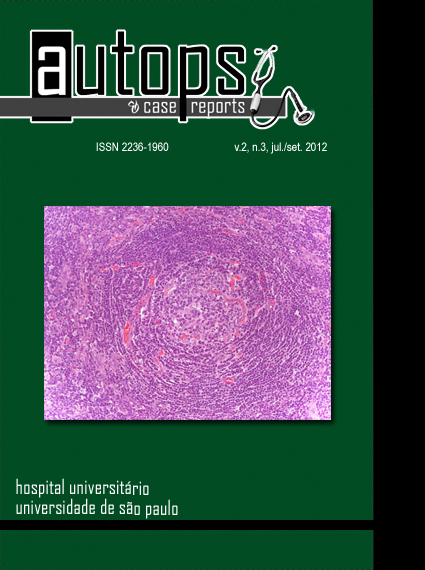Castleman disease: an uncommon diagnosis in pediatrics
DOI:
https://doi.org/10.4322/acr.%25y.48199Keywords:
Lymphoproliferative disorders, Giant lymph node hyperplasia, Biopsy, Lymph node excision.Abstract
First described by Dr. Benjamin Castleman in 1956, Castleman disease is an uncommon disease of an etiology that is not yet thoroughly known. Three distinct histological subtypes have already been described: hyaline-vascular-, plasma cell-, and human herpes virus 8-associated variant, clinically distinguished in multi or unicentric types. Castleman disease is occasionally diagnosed in children, but more often in young adults, with no gender predominance. The symptoms are rather heterogeneous, varying from an asymptomatic mass in the unicentric Castleman disease type, to life-threatening systemic inflammatory state with systemic symptoms in the multicentric Castleman disease type. The authors report a case of a 15-year-old boy who sought medical attention due to a cervical tumor mass, without systemic symptoms. Pathology exam of the excised mass diagnosed a very typical example of the hyaline-vascular unicentric type of Castleman disease.Downloads
Download data is not yet available.
Downloads
Published
2012-09-09
Issue
Section
Article / Clinical Case Report
License
Copyright
Authors of articles published by Autopsy and Case Report retain the copyright of their work without restrictions, licensing it under the Creative Commons Attribution License - CC-BY, which allows articles to be re-used and re-distributed without restriction, as long as the original work is correctly cited.
How to Cite
Vianna, P. M., Pastore, P. G., Cristofani, L., Siqueira, S. A. C., Aldred, V., Campos, F. P. F. de, & Zerbini, M. C. N. (2012). Castleman disease: an uncommon diagnosis in pediatrics. Autopsy and Case Reports, 2(3). https://doi.org/10.4322/acr.%y.48199



